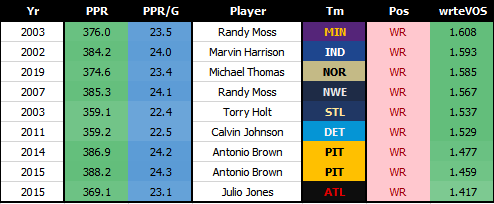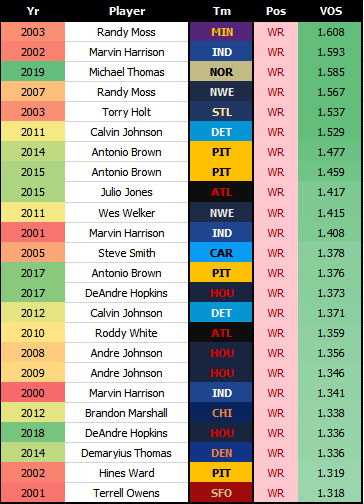The one (and only) good thing about fantasy football season ending is that we have plenty of time to analyze what happened during the past few months and put performances into context to prepare for next season. As football is an ever-evolving game, though, it makes sense to assess how good players were in fantasy leagues according to how the rest of the players in the league performed. That is what I will be doing in this series of articles, one per skill position.
In order to know how good a starter (top 12 for QBs and TEs, top 24 for RBs and WRs; the number of starters per position in Yahoo! standard leagues without considering the FLEX spot) was in any given season we shouldn't just look at his numbers in a vacuum, but rather in that year's environment. To do that we can use what I've called Value Over Starter or VOS. VOS is calculated on the basis of the top performers' fantasy points obtained during the full season, so different years have different performing levels (for example, a great passing year in 2019 might look more impressive than one in 2000 in terms of counting stats, but the best 2000 passer might have had a better year when compared to his contemporaries in their context).
This article will cover the wide receiver position and the top-24 players (that is, WR1/WR2) at the position during the past 20 years going from the 2000 season to the just finalized 2019 campaign. Let's get started!
Featured Promo: Get any full-season NFL Premium Pass for 50% off and win big in 2022. Exclusive access to our Premium articles, 15 lineup tools, new Team Sync platform, Lineup Optimizer, Premium DFS tools and cheat sheets, and much more! Sign Up Now!
Value Over Starter: A Quick Primer
As I already introduced in my first article, I'll be using the Value Over Starter metric to asses how good a player was in a given season compared to the rest of starters at his position. The VOS metric is calculated following a simple set of steps:
- Divide each player's total fantasy points into three categories: passing (paPPR), rushing (ruPPR), and receiving (rePPR); knowing what each stat is worth in PPR-format fantasy leagues (0.1 points per receiving yard, 6 points per rushing touchdown, 1 point per reception, etc...)
- Calculate the total points generated by the top 12 QBs and TEs and the top 24 RBs and WRs for each category.
- For each player inside those top 12 or top 24, subtract his paPPR, ruPPR, and rePPR for the combined addition for the position/year/category, then divide that number by 11 or 23 depending on the position.
- Divide the player value for each category by the number calculated in Step 3. The resulting number would tell us if the player was dead average among starters (VOS 1), if he performed over the starters' average level in that position in that category (VOS>1), or if he performed under the starters' average level in that position in that category (VOS<1)
Quarterback's VOS is based on both the passing and rushing categories, running backs' VOS is based on both the rushing and receiving categories, and wide receivers' and tight ends' VOS is based just on the receiving category.
Here is an example of the calculation to make things a bit clearer and allow you to replicate the method if you want to. Taking Lamar Jackson's 2019 season and following the steps aforementioned:
- Jackson scored 417.7 total points in 2019. 259.1 of those came via passing (259.1 paPPR), and 160.6 came via rushing (160.6 ruPPR).
- Top-12 QBs (starters at the position in standard leagues) combined for 3048.2 paPPR and 664.7 ruPPR.
- If Lamar Jackson had not been part of that top-12, the average starter would have averaged (3048.2-259.1 divided by 11) 253.6 paPPR, and (664.7-160.6 divided by 11) 45.8 ruPPR on the season.
- Lamar Jackson's passing VOS would come from dividing his paPPR by the average of the other 11 starters (259.1/253.6) and would yield a 1.02 paVOS. Same with the ruPPR (160.6/45.8) for a 3.50 ruVOS. Jackson's QB VOS in 2019 would be paVOS+ruVOS = 4.52 VOS, then adjusted for the season's environment taking in consideration the percentage of points the average starter got from passing/rushing/receiving stats. The final value comes down to 1.374 VOS on the 2019 season for Jackson, making him the leader among all starters.
2019 WR1/WR2 In Historical Context
Now that you know how the VOS metric works, we can put the 2019 wide receiver class in context. There have been 480 top-24 wide receivers since 2000. The best of them had a 1.608 VOS (2003 Randy Moss) while the worst had a 0.213 VOS (2000 Jamal Lewis). In terms of seasons, here is how things look like historically:

As you can see, and relative to each year's context, the 2019 season was indeed one for the ages. The best WR (WR1) was the third-best ever among his peers other than in 2002 and 2003, while the worst WR (WR24) was the best ever in context. Michael Thomas finished the season as WR1 with a 1.585 VOS while Stefon Diggs was the WR24 with a 0.844 VOS (A.J. Brown had the lowest VOS at 0.840 but finished WR21).
While looking at the individual player/season entries of the last 20 years, Michael Thomas' 1.585 VOS ranks third all-time only behind 2003 Randy Moss and 2002 Marvin Harrison:

You might wonder why Moss' 2007 season was the best among the top-six in terms of total FP and average FP/G, but only ranked fourth in VOS. That is related to both the context of the 2007 season and what Moss did that year. In 2007, the average starting wide receiver (WR1/WR2, that is, the top-24 players at the position) was better than those of 2019, 2002, and 2003, which made Moss look less impressive when compared to his peers.
Antonio Brown's 2015 and 2014 seasons are impacted more by what he himself did during those years. He had a slightly better season in 2015, but that difference came from his rushing and not his receiving. As rushing is not factored into a wide receiver's VOS, Brown's 2014 season ranks higher when considering him a "pure receiver".
The second-best 2019 wide receiver, Chris Godwin (276.1 FP, 19.7 FP/G) ranks a staggering 108th-overall among starters since 2000 with a 1.141 VOS. That means he only performed 14.1% better than the average WR1/WR2 this past season, so he didn't provide a really huge ROI to those rostering him in comparison to other top-tier receivers in 2019. Here are the top-25 WR seasons in VOS since 2000:

If you take a good look at the list, you'll notice there are only four players from the past three seasons on the list. That means that the WR position is featuring more similar players in terms of production, and therefore that the differences between the very best of them and the rest of top-tier players are not that exaggerated.
This can be seen in the 2019 WR1/WR2 leaderboard, pictured next:

While Michael Thomas had a season for the ages (376 rePPR), the rest of starting wide receivers all ranged between 275 and 205 rePPR. That is just a 70-point gap between 23 players, quite small compared to other years in which the second-best performer at the position and the 24th had much more notable differences.
More Fantasy Football Analysis
 RADIO
RADIO






















